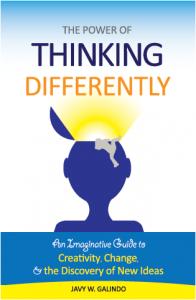The following is a an excerpt from a research paper entitled: “Creatively Exploring The Creative Process”
It is a brief summary of the association between creativity and neural networks.
—
Activating Unique Neural Networks
The brain consists of trillions of brains cells called neurons. Each of these neurons is typically connected to on upwards of 10,000 other neurons in a complex web forming a vast communication network (Andreasen, 2005, p. 58-59). Whenever we think, perceive, or act, a unique activation of neural firing patterns occurs (Damasio, 2003, p. 198). For example, thinking of a hammer will activate a particular network of neurons that correspond to what we associate with it, such as its size, its look, its use, and other previous memories of our experience with it. And, as we continue to think of a hammer in the same way, associating it with the same attributes over and over again, the same neural firing patterns are reinforced (Greenfield, 2000, p. 65-66). By reinforcing particular neural firing patterns, we make it easier for us to come to quick discernments as to what a hammer can do, what it looks like, or how to use it. However, it also makes it difficult to conceive of a hammer in a new light.
The creative process within this framework is the practice of weakening dominant neural networks in order to form novel ones. Dominant networks may be apparent in the musician who can only conceive of music in a 4/4 meter, in the movie producer who only knows one way to make films, in the minds of people who cannot fathom a female executive, or in a company that cannot look beyond a particular mold of product. By weakening dominant neural networks, new neural associations can be formed that enables one to imagine new possibilities. Jazz pianist Dave Brubeck weakened his dominant neural networks by exposing himself to Middle Eastern and Indian music (Tharp, 2003, p 114-115). As a result, he was able to conceive one of his most famous songs, Take Five, which is exclusively in 5/4 meter. Dominant neural networks prevented Harry Warner, president of Warner Brothers, from envisioning the future of films. In 1927 he was quoted as saying, “Who the hell wants to hear actors talk?” (Zelinski, 1998, p 60). By weakening neural networks Queen Elizabeth was able to rules in spite of the dominant negative preconceptions about female abilities (Gelb, 2002, p. 154). Furthermore, everyone laughed at Gary Dahl’s simple, yet apparently preposterous idea that people would spend money to purchase a pet rock (Zelinski, 1998, p. 48).
The neurological mechanism for weakening these dominant networks is associated with the division of labor of the brain hemispheres. In general, for right-handed people the right hemisphere is responsible for learning and processing new information, while the left hemisphere is the storehouse of learned information and behaviors (Goldberg, 2005, p. 202). Specifically, regions in the right hemisphere called the association cortex are what appear active when our unconscious mind seems to make new connections. As we age we become more dependent on the left hemisphere for performing our routine actions. Hence, our conscious attention is often directed toward the learned data of our left hemisphere, and away from the new connections that our right hemisphere is processing in the background. Our left hemisphere is then exercised more than our right. As a result, the part of brain involved with making new connections and new behaviors becomes weakened over time from lack of use.
Moreover, the creative process is not simply a mechanism of one particular hemisphere, but is dependent on a healthy collaboration between the two. Due to its significant role in forming new associations, many books on creativity refer to the right hemisphere as the creative brain. Yet, though split-brain patients have a healthy right hemisphere and display normal behavior, they are unable to exhibit much creativity. This is because the new associations made by the right hemisphere have no way of manifesting themselves – either through meaningful thoughts, words, images, sounds, etc… – which is the function of the left hemisphere (Restak, 1994, p. 165). Studies show that when individuals are being creative there exists a great deal of interhemispheric communication, something split-brain patients lack.
Neuroscience points to several ways of exercising or promoting the creative process. For instance, meditation and free association have been shown to increase activity in the association cortices (Andreasen, 2005, p 163-164). This makes sense, as relaxation quiets our most active neural firing patterns — those that exist in our left hemisphere — while free association seems to help destabilize them. Additionally, the right hemisphere can be exercised by using our imaginative and interpretative faculties to explore multiple meanings and perspectives (Ornstein, 1997, p 73). What’s more, the neural networks of the left hemisphere can be deconstructed using many of the divergent thinking techniques already mentioned. These include challenging assumptions, intentionally exploring new associations, and reframing. By practicing divergent thinking, it may eventually become a higher heuristic that makes creative thinking a habit.
The neuroscientific framework of creativity seems to speak to many of the perspectives explored thus far. Entering the intersection and stepping out of the stream referred to making new associations and stepping out of old ones, respectively. Neuroscience articulates this in terms of making new neural connections by weakening dominant ones. Also, where the context of a tortoise mind frames the creative process around the unconscious, neuroscience speaks of how the exploration of new associations is reliant on the unconscious ruminations of the association cortices in the right hemisphere. Lastly, while the process of the creative genius emphasizes the hard work needed in preparation of manifesting creative expression, neuroscience refers to the significance of the left hemisphere in manifesting the creative associations of the right hemisphere. It then appears that while there are many languages with which one can articulate the creative process, these perspectives are not necessarily unrelated.
—
Please leave comments, questions, and suggestions below.



Trackbacks/Pingbacks
Buy:Zithromax.Viagra Soft Tabs.Viagra Professional.Viagra Super Active+.Cialis.Super Active ED Pack.Viagra.Soma.Maxaman.VPXL.Cialis Super Active+.Cialis Professional.Propecia.Cialis Soft Tabs.Viagra Super Force.Levitra.Tramadol….